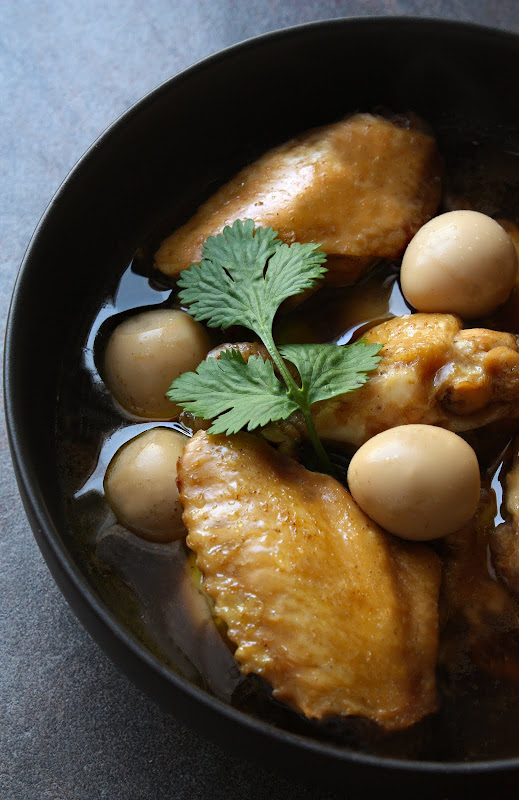
This version is not exactly a Pa-Lo as it does not contain five-spice powder or any individual spices therein; instead it features quite prominently the flavor and fragrance of the quintessential Thai marinade paste of garlic, white peppercorns, and cilantro roots. Also, while the Thai use soy sauce as the main source of salinity according to the Chinese tradition along with fish sauce, they — true to form — have often opted for palm or coconut sugar as the sweetener. This dish is also a bit sweeter than its traditional Chinese prototype.
My aunt’s version employs a lazy streamlined method. Instead of starting off with a caramel base as traditionally done, she just dumps the palm sugar into the braising liquid as the chicken is cooking. We haven’t gotten any complaints as far as I know. If the caramel base is very important to you, I’m afraid this recipe will be a disappointment and suggest that you skip it.

Quail eggs and individual chicken wing joints are used here because of the cute factor more than anything. This aunt of mine has four kids and she is the master of kid-friendly food preparation and presentation. If cuteness means squat to you, chicken thighs, drumsticks, or whole wings would be fine; as do chicken or duck eggs. But if you have a thing for tiny foods, you can miniaturize the dish like I’ve done here.
Lastly, you can prepare your own quail eggs, or you can buy ones that come cooked and peeled in 15-ounce cans (found at most Asian grocery stores). Fresh quail eggs certainly taste far better than canned quail eggs. But if the idea of peeling two dozen hard-boiled quail eggs doesn’t appeal to you, tell yourself — as I do — that martyrdom is overrated and use canned eggs. They’re really not that bad. Whatever eggs you use, be sure to peel them without exposing the yolks for failure to do so means that the finished dish will feature chicken swimming in an unappetizing cloudy, pasty pool of sauce. Not a big deal, but you know …
Soy-Braised Chicken Wings with Quail Eggs (ปีกไก่ต้มเค็มกับไข่นกกระทา)
Serves 4-6
Printable Version
2 lbs chicken wing drummettes and middle joints
24 hard-boiled and peeled quail eggs (or two 15-ounce cans of quail eggs)
4 large cloves garlic, peeled
2 teaspoons whole white (or black) peppercorns
200 grams palm sugar
3 tablespoons finely-chopped cilantro roots or stems
1 tablespoon vegetable oil
1/3 cup dark sweet soy sauce (kecap manis)
2 tablespoons of fish sauce
Dark or “white” soy sauce, to taste
(Information on the different soy sauces used here can be found in this post.)
Fresh cilantro for garnish
- In a mortar, pound the garlic, peppercorns, and cilantro roots together to form a smooth paste. You can also use a small chopper for this task.
- In a large, heavy-bottomed pot, fry the paste in vegetable oil and 3 tablespoons of plain water over medium-low heat just until the paste becomes lightly toasted.
- Put the chicken wing joints and the hard-boiled eggs into the pot, followed by just enough to barely cover them.
- Add the sweet dark soy sauce, fish sauce, and about 1/4 cup of dark soy sauce as a start (you can adjust the saltiness later on; this is just to give the chicken pieces enough flavor as they braise).
- Add the palm sugar to the pot. I find 200 g of palm sugar to be just right, but you may want add half of it first then adjust later.
- Bring the whole pot to a boil; reduce to a gentle simmer and let the whole thing braise. Be sure to check for the liquid level occasionally. There should always be enough liquid to barely cover the chicken and the eggs and no more. If the liquid level falls below that point, replenish it with more plain water and restore the simmer.
- After about 30 minutes, the chicken should be tender and the eggs should have taken on the color of the soy sauces. Taste for seasoning and adjust accordingly.
- Garnish with fresh cilantro leaves and serve with rice.







4 Responses to Soy-Braised Chicken Wings with Quail Eggs (ปีกไก่ต้มเค็มกับไข่นกกระทา)